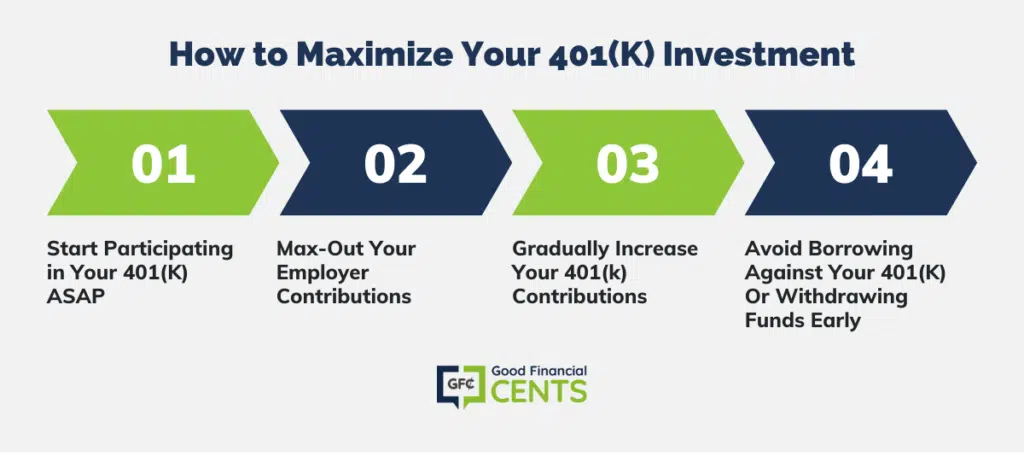The 401(k) plan is the very best retirement plan available to the average American. If the plan is offered through your employer, you should absolutely take advantage of it.
Along the way, do whatever you can to maximize your contributions, as well as the performance of the plan.
Table of Contents
How to Maximize Your 401(k) Investment
There are several strategies on how to invest and maximize your contributions while doing it.
Start Participating in Your 401(k) ASAP
It often seems logical to delay participating in your retirement plan until a bit later in life, when your finances are more solid. For example, you might decide to wait until you pay off your student loan debt. But since that can take many years, there’ll be a serious penalty for waiting on the retirement plan.
For example, let’s say beginning at age 25, you begin contributing 10% of your $50,000 income to your 401(k) plan. Assuming an average annual rate of return on investment of 7% (a mix between stocks and bonds), you’ll have approximately $1.035 million dollars saved by the time you’re 65.
But if you wait until you’re 35 and begin contributing 10% of your $100,000 income, again assuming a 7% annual rate of return, you’ll have only a little over $980,000 by the time you reach 65.
We haven’t even taken into account that if you begin making contributions at 25, you’ll gradually increase your contributions based on a higher annual income. Assuming a 3% annual increase in salary, your plan will grow to over $1.55 million by age 65, keeping the contribution rate at 10%.
Timing is everything with a 401(k).
Max-Out Your Employer Contributions
A common question with a 401(k) plan is, “How much should I contribute?” The best answer to that question is as much as you can!
For example, contributing 10% is better than 5%, and 15% is better than 10%. But at a minimum, you should make at least the lowest percentage contribution that will produce the maximum employer-matching contribution.
For example, if your employer will match 50% of your contribution, up to 10% from you (resulting in a 5% match), then you should contribute at least 10%.
Between your 10% contribution and your employer’s 5% match, you’ll have 15% of your income going into your plan each year.
Using the example above, by contributing 10% of your income beginning at age 25, a 50% employer match will result in about $1,552,500 by age 65. That’s how important the employer matching contribution is.
One limitation to be aware of with the employer match isthe vesting of contributions. Vesting refers to the point at which funds contributed to your 401(k) plan fully belong to you.
Your own contributions to the plan are automatically vested when made since the funds come out of your own income. However, employer matching contributions usually delay vesting.
For example, vesting can take as long as six years before 100% of the employer match will belong to you.
Depending on how the vesting schedule is set up for your plan, employer contributions may be vested on a percentage basis each year. For example, 20% of the match may be vested after the second year you’re in the plan, then 40% after the third year, and so on. Usually, after five or six years, you’re fully vested.
Consequences of Leaving Before You’re Fully Vested
Should you leave your employer before you’re fully vested, you may be entitled to keep only a certain percentage of the match. And if you leave too soon, you may not be able to keep any of the matches.
Employers use extended vesting schedules as a way to keep employees with the company for several years. It’s particularly effective if the employer offers a very generous matching contribution.
The vesting schedule will necessarily be an important factor if you’re considering leaving your employer before you’re fully vested.
Gradually Increase Your 401(k) Contributions
So far, we’ve given examples of contributing a fixed percentage of your salary to your 401(k) plan. Since your salary is likely to increase over the years, the dollar amount of your contributions will rise as they do. If you contribute 10% of a $50,000 salary in your first year of employment, you’ll save $5,000 in the plan.
But if you’re making $100,000 10 years later and still contributing 10%, your annual contribution will increase to $10,000. That will naturally result in an even higher plan balance by the time you reach 65. But an even more effective way to make your plan grow faster is to increase your contribution percentage.
This strategy isn’t as dramatic as it sounds. Maybe in the first year, you contribute 10% to get the maximum 5% employer matching contribution. But let’s say your salary increases by an average of 3% per year. With each increase, you allocate an additional 1% to your 401(k) contribution.
After your first raise, your contribution percentage will increase to 11%. After the second raise, it will increase to 12%. By the time you have five raises, it will increase to 15%.
If you continue using that strategy for an additional five years, you’ll eventually be contributing 20% of your pay to the plan. And since the increases are gradual and tied to your pay hikes, you won’t even notice it.
You can continue increasing your percentage contributions until you reach the maximum contribution limits for the plan. For 2024, that’s $23,000 per year or $30,500 if you’re 50 or older.
Your ultimate goal should be to get as close as possible to the maximum contribution allowed by the IRS. That, plus your employer’s matching contribution, can seriously supercharge your plan.
Avoid Borrowing Against Your 401(k) or Withdrawing Funds Early
Both borrowing against your 401(k) and withdrawing funds early can degrade the value of the plan. Here’s how:
401(k) Loans
IRS regulations allow you to borrow up to 50% of the vested balance of your 401(k) plan, up to a maximum of $50,000. But that’s both good news and bad news.
On the good side, you can borrow against your 401(k) plan without needing to qualify based on income or credit history. The interest rate is typically lower than what you will pay for a bank loan and certainly lower than credit card rates. And since the monthly repayments will come out of your regular 401(k) contributions, they won’t make a dent in your budget.
But there are several reasons why you should avoid borrowing against your 401(k):
- Even though the IRS permits 401(k) loans, not all employers offer them.
- The primary purpose of a 401(k) plan is retirement. By borrowing against the plan, you’ll be at least somewhat impairing that effort.
- The outstanding loan balance will not be available for investments, reducing the overall return on your plan.
- Loan repayments on a 401(k) loan aren’t tax-deductible.
There’s another important restriction when it comes to 401(k) loans. If you have a loan outstanding and you terminate your employment for any reason, you’ll be required to repay the loan. Under the most recent tax law, you’ll have until the due date for the tax return covering the year of termination, including extensions, to repay the loan.
If you don’t, the outstanding loan proceeds will be considered as a premature distribution, subject to ordinary income tax, plus a 10% penalty if you’re under age 59 ½.
Early Withdrawals
Once again, the whole purpose of a 401(k) plan is to provide for your retirement. If taking loans against the plan can reduce its future value, early withdrawals are even more destructive.
For many people, retirement savings are their primary savings. That makes sense since they’ll need to provide for the last several decades of your life. But if you don’t have much in the way of non-retirement savings, you may be tempted to withdraw funds from your 401(k) plan to cover any financial needs.
In most cases, you won’t be allowed to withdraw funds from the plan with your current employer. But you may be able to withdraw funds from an old 401(k) plan or one that’s been rolled over into an IRA account.
If you do withdraw funds from a retirement plan, you’ll have up to 60 days to return the funds. Otherwise, they’ll be considered early distributions. Similar to unpaid 401(k) loan proceeds, they’ll be subject to ordinary income tax, plus a 10% penalty if you’re under age 59 ½.
But just as bad, early withdrawals from a 401(k) or any other retirement plan have a way of not finding their way back. That means they become permanent withdrawals from plans intended to finance your retirement.
If you do have a short-term need for additional funds, exhaust every other possibility before turning to early withdrawals from your retirement plan.

Create the Right Portfolio Mix for Your Age, Goals, Time Horizon, and Risk Tolerance
Apart from how much you contribute to your 401(k) plan, the next most important factor is how effectively you invest the money. To get the most bang for your retirement investment buck, you’ll need to have the right mix of stocks and bonds in your portfolio.
Probably the most common strategy for determining the mix of stocks and bonds in a portfolio today is 120 minus your age. The difference is the percentage of your portfolio that should be invested in stocks, with the balance allocated to bonds.
It’s just a rule of thumb, and you can adjust it to your own personal preferences. But it works something like this:
Let’s say you’re 25 years old. You determine your stock portfolio by deducting your age – 25 – from 120. That gives you 95. It means 95% of your portfolio should be invested in stocks and 5% in bonds. If you’re 40 years old, 80% should be invested in stocks (120 minus 40), with 20% in bonds.
Because the formula is based on your age, your stock allocation will be gradually reduced as you get older.
As to the specific investments you should hold in your retirement plan, these will largely be determined by the options available in your plan. But generally speaking, your investments should be held in index-based exchange-traded funds (ETFs). These are low-cost funds that are tied to specific market indexes. That enables you to invest in a market without needing to select individual stocks.
How to Best Manage Your 401(k)
Probably the most effective overall strategy for managing a 401(k) plan is to be consistent.
A 401(k) plan, like any retirement plan, is a long-term investment. It’ll require a long-term perspective, as well as an ongoing commitment.
Make sure you fund your plan each and every year you’re eligible to do so. It’s especially important to fund your plan regularly during the first few years you’re in it. The time value of money holds that the longer money is invested, the greater the return on the plan will be.
Again, you should plan to gradually increase your percentage contributions as your income grows.
Diversify Your Retirement Portfolio Allocation
Proper diversification is also important. If you have 80%, 90%, or more invested in stocks, you’ll need to spread that across several sectors.
While you should have a large allocation in US stocks, particularly the S&P 500 Index, you should also have an allocation in international stocks. This can be split evenly between developing and emerging markets.
You may be unsure exactly how to create a solid portfolio allocation. If so, try completing a risk tolerance questionnaire to help with the process. You can find these with any of the major brokerages, including Vanguard and Charles Schwab.
Rebalancing Your Portfolio
Rebalancing your portfolio is another often neglected management strategy. Unless your 401(k) plan offers some type of investment management, you’ll need to handle this on your own.
Rebalancing is just a matter of keeping your portfolio allocations consistent with your investment targets. For example, if you’ve determined that 80% of your portfolio should be invested in stocks and 20% in bonds, that split can change over time. If your stock portfolio has grown significantly, and your bonds haven’t, you may have 90% in stocks and 10% in bonds.
You’ll need to make adjustments. You can do that by reducing your stock allocation to 80% and raising your bond percentage to 20%.
You should plan to rebalance at least annually or any time a single market sector has experienced significant growth.
If you don’t feel confident managing your 401(k) portfolio yourself, you can use a 401(k) management service called Blooom. They’ll manage your plan investments for you for a very small fee. And you won’t even need approval from your employer or the plan administrator.
Will You Maximize Your 401(k) Investment?
If properly managed – and to get the best long-term effect – a 401(k) plan should be put on automatic pilot.
You’ll set your payroll contributions, make them consistently, determine your portfolio allocation, and rebalance it periodically.
Along the way, you should also have a strategy to gradually increase your plan contributions. You should also avoid either taking loans or early distributions from the plan.
Set it up that way and manage it properly, and it will be the perfect passive way to develop long-term wealth!







